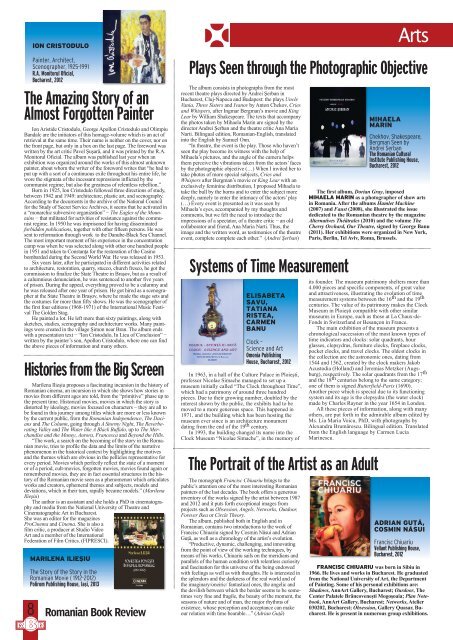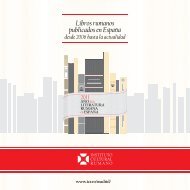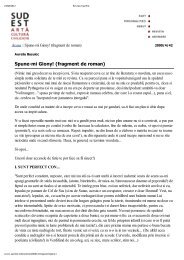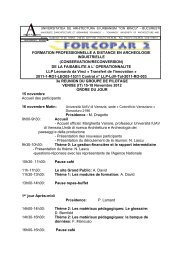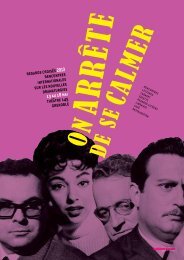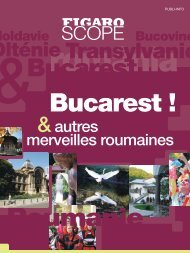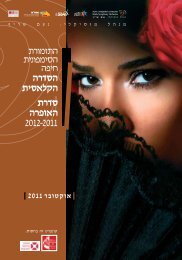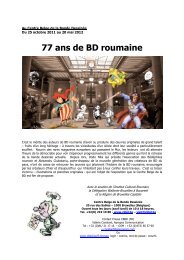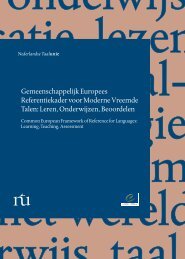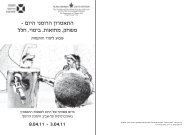Three Days With Romanian Books in Prague - Institutul Cultural ...
Three Days With Romanian Books in Prague - Institutul Cultural ...
Three Days With Romanian Books in Prague - Institutul Cultural ...
You also want an ePaper? Increase the reach of your titles
YUMPU automatically turns print PDFs into web optimized ePapers that Google loves.
ION CRISTODULO<br />
Pa<strong>in</strong>ter, Architect,<br />
Scenographer, 1925-1991<br />
R.A. Monitorul Oficial,<br />
Bucharest, 2012<br />
The Amaz<strong>in</strong>g Story of an<br />
Almost Forgotten Pa<strong>in</strong>ter<br />
Ion Aristide Cristodulo, George Apollon Cristodulo and Olimpiu<br />
Bandalc are the <strong>in</strong>itiators of this homage-volume which is an act of<br />
retrieval at the same time. Their name is neither on the cover, nor on<br />
the front page, but only <strong>in</strong> a box on the last page. The foreword was<br />
written by the art critic Pavel Şuşară, and it was pr<strong>in</strong>ted by the R.A.<br />
Monitorul Oficial. The album was published last year when an<br />
exhibition was organized around the works of this almost unknown<br />
pa<strong>in</strong>ter, about whom the writer of the foreword writes that “he had to<br />
put up with a sort of a cont<strong>in</strong>uous exile throughout his entire life, he<br />
wore the stigmata of the <strong>in</strong>cessant repressions <strong>in</strong>flicted by the<br />
communist regime, but also the greatness of relentless rebellion.”<br />
Born <strong>in</strong> 1925, Ion Cristodulo followed three directions of study,<br />
between 1942 and 1949: architecture, plastic art, and scenography.<br />
Accord<strong>in</strong>g to the documents <strong>in</strong> the archive of the National Council<br />
for the Study of Secret Service Archives, it seems that he activated <strong>in</strong><br />
a “monarchic subversive organization” − The Eagles of the Mounta<strong>in</strong>s<br />
− that militated for activities of resistance aga<strong>in</strong>st the communist<br />
regime. In 1950 he was imprisoned for hav<strong>in</strong>g dissem<strong>in</strong>ated<br />
forbidden publications, together with other fifteen persons. He was<br />
sent to reformation through work to the Danube-Black Sea Channel.<br />
The most important moment of his experience <strong>in</strong> the concentration<br />
camp was when he was selected along with other one hundred people<br />
<strong>in</strong> 1951 and taken to Constanţa for the restoration of the Cas<strong>in</strong>o<br />
bombarded dur<strong>in</strong>g the Second World War. He was released <strong>in</strong> 1953.<br />
Six years later, after he participated <strong>in</strong> different activities related<br />
to architecture, restoration, quarry, stucco, church fresco, he got the<br />
commission to f<strong>in</strong>alize the State Theatre <strong>in</strong> Braşov, but as a result of<br />
a calumnious denunciation, he was sentenced to another five years<br />
of prison. Dur<strong>in</strong>g the appeal, everyth<strong>in</strong>g proved to be a calumny and<br />
he was released after one year of prison. He got hired as a scenographer<br />
at the State Theatre <strong>in</strong> Braşov, where he made the stage sets and<br />
the costumes for more than fifty shows. He was the scenographer of<br />
the first four editions (1968-1971) of the International Music Festival<br />
The Golden Stag.<br />
He pa<strong>in</strong>ted a lot. He left more than sixty pa<strong>in</strong>t<strong>in</strong>gs, along with<br />
sketches, studies, scenography and architecture works. Many pa<strong>in</strong>t<strong>in</strong>gs<br />
were created <strong>in</strong> the village Şimon near Bran. The album ends<br />
with a presentation text − “Ion Cristodulo, In Lieu of Conclusion” −<br />
written by the pa<strong>in</strong>ter’s son, Apollon Cristodulo, where one can f<strong>in</strong>d<br />
the above pieces of <strong>in</strong>formation and many others.<br />
Histories from the Big Screen<br />
Marilena Ilieşiu proposes a fasc<strong>in</strong>at<strong>in</strong>g <strong>in</strong>cursion <strong>in</strong> the history of<br />
<strong>Romanian</strong> c<strong>in</strong>ema, an <strong>in</strong>cursion <strong>in</strong> which she shows how stories <strong>in</strong><br />
movies from different ages are told, from the “primitive” phase up to<br />
the present time. Historical movies, movies <strong>in</strong> which the story is<br />
distorted by ideology, movies focused on characters − they are all to<br />
be found <strong>in</strong> this journey among titles which are more or less known<br />
by the current public, from the <strong>Romanian</strong> Independence, The Dacians<br />
and The Column, go<strong>in</strong>g through A Stormy Night, The Reverberat<strong>in</strong>g<br />
Valley and The Water like A Black Buffalo, up to The Merchandise<br />
and the Money, Aurora, Francesca and Beyond the Hills.<br />
“The work, a search on the becom<strong>in</strong>g of the story <strong>in</strong> the <strong>Romanian</strong><br />
movie, tries to profile the data and the limits of the narrative<br />
phenomenon <strong>in</strong> the historical context by highlight<strong>in</strong>g the motives<br />
and the themes which are obvious <strong>in</strong> the pellicles representative for<br />
every period. Movies which perfectly reflect the state of a moment<br />
or of a period, cult-movies, forgotten movies, movies found aga<strong>in</strong> or<br />
remembered movies, they are <strong>in</strong> fact essential structures <strong>in</strong> the history<br />
of the <strong>Romanian</strong> movie seen as a phenomenon which articulates<br />
works and creators, ephemeral themes and subjects, models and<br />
deviations, which <strong>in</strong> their turn, rapidly became models.” (Marilena<br />
Ilieşiu)<br />
The author is an assistant and she holds a PhD <strong>in</strong> c<strong>in</strong>ematography<br />
and media from the National University of Theatre and<br />
C<strong>in</strong>ematographic Art <strong>in</strong> Bucharest.<br />
She was an editor for the magaz<strong>in</strong>es<br />
ProC<strong>in</strong>ema and C<strong>in</strong>ema. She is also a<br />
film critic, a producer at Studio Video<br />
Art and a member of the International<br />
Federation of Film Critics. (FIPRESCI).<br />
MARILENA ILIE±IU<br />
The Story of the Story <strong>in</strong> the<br />
<strong>Romanian</strong> Movie ( 1912-2012)<br />
Polirom Publish<strong>in</strong>g House, Ia§i, 2013<br />
8<br />
<strong>Romanian</strong> Book Review<br />
Plays Seen through the Photographic Objective<br />
The album consists <strong>in</strong> photographs from the most<br />
recent theatre plays directed by Andrei Şerban <strong>in</strong><br />
Bucharest, Cluj-Napoca and Budapest: the plays Uncle<br />
Vania, <strong>Three</strong> Sisters and Ivanov by Anton Chekov, Cries<br />
and Whispers, after Ingmar Bergman’s movie and K<strong>in</strong>g<br />
Lear by William Shakespeare. The texts that accompany<br />
the photos taken by Mihaela Mar<strong>in</strong> are signed by the<br />
director Andrei Şerban and the theatre critic Ana Maria<br />
Narti. Bil<strong>in</strong>gual edition, <strong>Romanian</strong>-English, translated<br />
<strong>in</strong>to the English by Samuel Onn.<br />
“In theatre, the event is the play. Those who haven’t<br />
seen the play become its witness with the help of<br />
Mihaela’s pictures, and the angle of the camera helps<br />
them perceive the vibrations taken from the actors’ faces<br />
by the photographic objective (…) When I <strong>in</strong>vited her to<br />
take photos of more special subjects, Cries and<br />
Whispers after Bergman’s movie or K<strong>in</strong>g Lear with an<br />
exclusively fem<strong>in</strong><strong>in</strong>e distribution, I proposed Mihaela to<br />
take the bull by the horns and to enter the subject more<br />
deeply, namely to enter the <strong>in</strong>timacy of the actors’ play<br />
(…) Every event is presented as it was seen by<br />
Mihaela’s eyes, accompanied by my thoughts and<br />
comments, but we felt the need to <strong>in</strong>troduce the<br />
impressions of a spectator, of a theatre critic − an old<br />
collaborator and friend, Ana Maria Narti. Thus, the<br />
image and the written word, as testimonies of the theatre<br />
event, complete complete each other.” (Andrei Şerban)<br />
Systems of Time Measurement<br />
ELISABETA<br />
SAVU,<br />
TATIANA<br />
RISTEA,<br />
CARMEN<br />
BANU<br />
Clock –<br />
Science and Art<br />
Omonia Publish<strong>in</strong>g<br />
House, Bucharest, 2012<br />
In 1963, <strong>in</strong> a hall of the Culture Palace <strong>in</strong> Ploieşti,<br />
professor Nicolae Simache managed to set up a<br />
museum <strong>in</strong>itially called “The Clock throughout Time”,<br />
which had a patrimony of around three hundred<br />
pieces. Due to their grow<strong>in</strong>g number, doubled by the<br />
<strong>in</strong>terest shown by the public, the exhibits had to be<br />
moved to a more generous space. This happened <strong>in</strong><br />
1971, and the build<strong>in</strong>g which has been host<strong>in</strong>g the<br />
museum ever s<strong>in</strong>ce is an architecture monument<br />
dat<strong>in</strong>g from the end of the 19 th century.<br />
In 1993, the build<strong>in</strong>g changed its name <strong>in</strong>to the<br />
Clock Museum “Nicolae Simache”, <strong>in</strong> the memory of<br />
The monograph Francisc Chiuariu br<strong>in</strong>gs to the<br />
public’s attention one of the most <strong>in</strong>terest<strong>in</strong>g <strong>Romanian</strong><br />
pa<strong>in</strong>ters of the last decades. The book offers a generous<br />
<strong>in</strong>ventory of the works signed by the artist between 1987<br />
and 2012 and it puts forth exceptional images from<br />
projects such as Obsession, Angels, Networks, Outdoor,<br />
Forever Ikea or Circle Theory.<br />
The album, published both <strong>in</strong> English and <strong>in</strong><br />
<strong>Romanian</strong>, conta<strong>in</strong>s two <strong>in</strong>troductions to the work of<br />
Francisc Chiuariu signed by Cosm<strong>in</strong> Năsui and Adrian<br />
Guţă, as well as a chronology of the artist’s evolution.<br />
“Productive, dynamic, challeng<strong>in</strong>g, and <strong>in</strong>novat<strong>in</strong>g<br />
from the po<strong>in</strong>t of view of the work<strong>in</strong>g techniques, by<br />
means of his works, Chiuariu sails on the meridians and<br />
parallels of the human condition with relentless curiosity<br />
and fasc<strong>in</strong>ation for this universe of the be<strong>in</strong>g endowed<br />
with feel<strong>in</strong>gs as well as with thoughts. He is <strong>in</strong>terested <strong>in</strong><br />
the splendors and the darkness of the real world and of<br />
the imag<strong>in</strong>ary/oneiric/ fantastical ones, the angelic and<br />
the devilish between which the border seems to be sometimes<br />
very f<strong>in</strong>e and fragile, the beauty of the moment, the<br />
seasons of nature and of man, the major rhythms of<br />
existence, whose perception and acceptance can make<br />
our relation with time bearable…” (Adrian Guţă)<br />
The first album, Dorian Gray, imposed<br />
MIHAELA MARIN as a photographer of show arts<br />
<strong>in</strong> Romania. After the albums Hamlet Mach<strong>in</strong>e<br />
(2007) and Faust (2008), she illustrated the issue<br />
dedicated to the <strong>Romanian</strong> theatre by the magaz<strong>in</strong>e<br />
Alternatives Théâtrales (2010) and the volume The<br />
Cherry Orchard, Our Theatre, signed by George Banu<br />
(2011). Her exhibitions were organized <strong>in</strong> New York,<br />
Paris, Berl<strong>in</strong>, Tel Aviv, Roma, Brussels.<br />
its founder. The museum patrimony shelters more than<br />
4.000 pieces and specific components, of great value<br />
and attractiveness, illustrat<strong>in</strong>g the evolution of time<br />
measurement systems between the 16 th and the 19 th<br />
centuries. The value of its patrimony makes the Clock<br />
Museum <strong>in</strong> Ploieşti compatible with other similar<br />
museums <strong>in</strong> Europe, such as those at La Chaux-de-<br />
Fonds <strong>in</strong> Switzerland or Besançon <strong>in</strong> France.<br />
The ma<strong>in</strong> exhibition of the museum presents a<br />
chronological succession of the most known types of<br />
time <strong>in</strong>dicators and clocks: solar quadrants, hour<br />
glasses, clepsydras, furniture clocks, fireplace clocks,<br />
pocket clocks, and travel clocks. The oldest clocks <strong>in</strong><br />
the collection are the astronomic ones, dat<strong>in</strong>g from<br />
1544 and 1562, created by the clock makers Jakob<br />
Acustodia (Holland) and Jeremias Metzker (Augsburg),<br />
respectively. The solar quadrants from the 17 th<br />
and the 18 th centuries belong to the same category;<br />
one of them is signed Butterfield-Paris (1690).<br />
Another piece which is special due to its function<strong>in</strong>g<br />
system and its age is the clepsydra (the water clock)<br />
made by Charles Rayner <strong>in</strong> the year 1654 <strong>in</strong> London.<br />
All these pieces of <strong>in</strong>formation, along with many<br />
others, are put forth <strong>in</strong> the admirable album edited by<br />
Ms. Lia Maria Voicu, PhD, with photographs by<br />
Alexandru Brumărescu. Bil<strong>in</strong>gual edition. Translated<br />
from the English language by Carmen Lucia<br />
Mar<strong>in</strong>escu.<br />
The Portrait of the Artist as an Adult<br />
MIHAELA<br />
MARIN<br />
Arts<br />
Chekhov, Shakespeare,<br />
Bergman Seen by<br />
Andrei ±erban<br />
The <strong>Romanian</strong> <strong>Cultural</strong><br />
Institute Publish<strong>in</strong>g House,<br />
Bucharest, 2012<br />
ADRIAN GU|{,<br />
COSMIN N{SUI<br />
Francisc Chiuariu<br />
Vellant Publish<strong>in</strong>g House,<br />
Bucharest, 2012<br />
FRANCISC CHIUARIU was born <strong>in</strong> Sibiu <strong>in</strong><br />
1966. He lives and works <strong>in</strong> Bucharest. He graduated<br />
from the National University of Art, the Department<br />
of Pa<strong>in</strong>t<strong>in</strong>g. Some of his personal exhibitions are:<br />
Shadows, AnnArt Gallery, Bucharest; Ourdoor, The<br />
Center Palatele Brâncoveneşti Mogoşoaia; Plan Notebook,<br />
AnnArt Gallery, Bucharest; Networks, Atelier<br />
030202, Bucharest; Obsession, Gallery Quasar, Bucharest.<br />
He is present <strong>in</strong> numerous group exhibitions.


